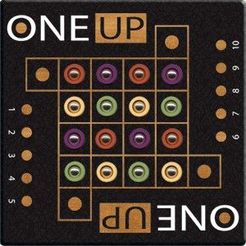Yesterday I had a dentist appointment. (Yay) It went well, but they wanted to repair/replace some older fillings. (Yay) As a result, I came home with a sore jaw and numb gums and not much interest in returning to work for the day. Instead, I spent the afternoon trying to figure out what to eat. And playing a series of abstract games with my son. Yay! And I mean it this time. 🙂
We played a series of games, some of which I had not played in a very long time, or in some cases ever. I like the concept of abstract games…Quarto remains one of my favorites. But I have other games from the same company as well as some others. We played:
- Quarto Three times
- Quixo Three times
- Pylos Three times
- Batik Twice
- One Up Three times
One of the above items is not like the others. All of the games listed are from a French company named Gigamic except for One Up which comes from Family Games instead.
Gigamic is one of my favorite abstract game publishers. Their games are all (in my experience) very high quality with sturdy wooden pieces. I have probably played more games of Quarto than any of the others. It involves trying to get four pieces in a row that share an attribute (height, color, shape, and density). Quixo was relatively new (I might have played it once or twice before). It starts with a 5×5 grid of blank cubes. On a player turn, they pick up a cube from the edge. If it is blank, turn it to their symbol (X or O). Finally, move the cube to another position where they can slide it in and cover the blank spot they created. The goal is to get five in a row. Pylos involves stacking wooden balls into a pyramid. The person to place their token last, wins. I think we were doing something wrong because the second player always won that game. I am sure there is a rule we were misinterpreting somewhere. Batik is a fun and more casual game. Each player owns a set of wooden pieces of different shapes. Players alternate dropping shapes into a container (two sheets of Plexiglas with a gap between them). The player who has the first piece to extend beyond the top of the container is the loser.
All of these Gigamic games are fun, quick, easy to teach, and in some cases surprisingly deep as far as the strategy required (or allowed). The are all two-person games as well.

On the first round, each player gets to move only one token. On the second round, each player gets to move two tokens. On the third round, three tokens. I think you can see where this is going. 😉 The game tops out at ten moves, but I would think it would end with four-in-a-row before someone needed ten turns.
All of these games offer different scenarios, each requiring a different type of thinking, are easy to teach, and — most importantly — are fun to play. And they don’t require you to have a dentist appointment on the same day to play.
What are some of your favorite abstract games?